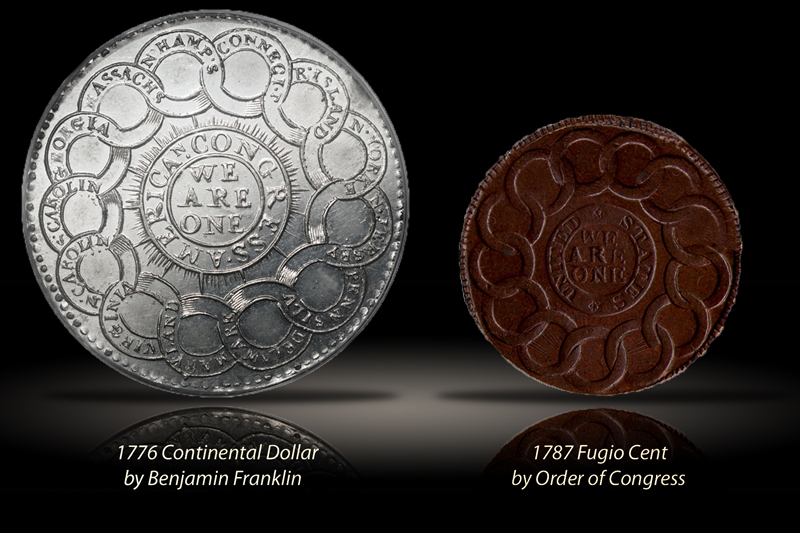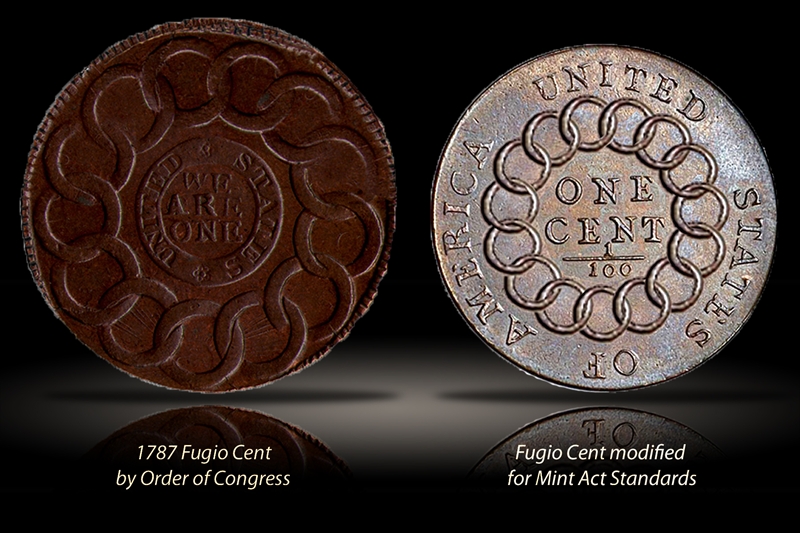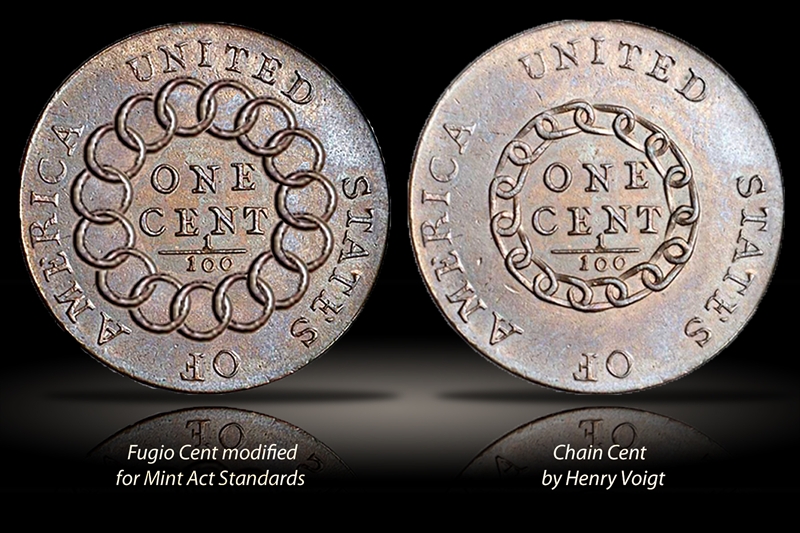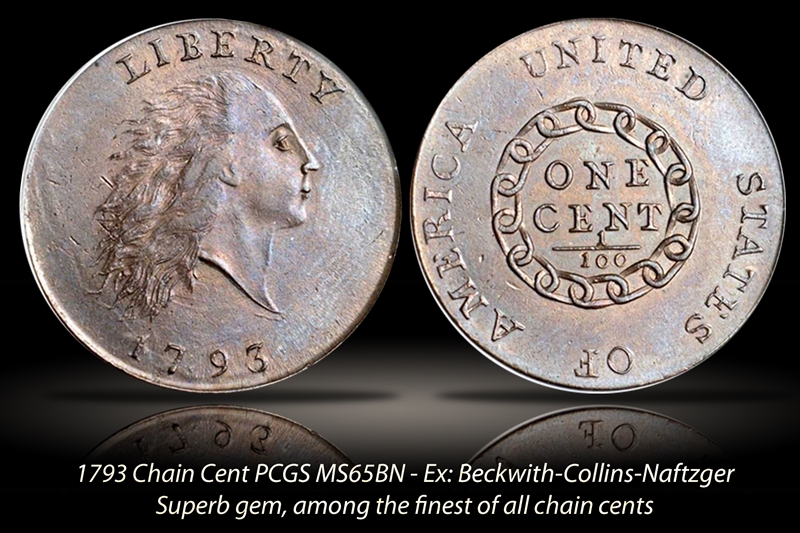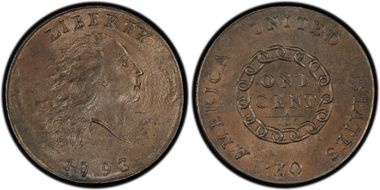1793 1C Chain, America, BN MS65BN 认证号50070517, PCGS号1341
拥有者评论
The 1787 Fugio Cent is credited with being the first coin issued under the authority of the United States. Its design, following the 1776 Continental Dollar designed by Benjamin Franklin, was established by Congressional resolution on Friday, July 6, 1787 to bear on one side “thirteen circles linked together.”-----------------------------------------**The Mint Act of April 2, 1792, stated other design requirements, including the inscription “United States of America” and “an inscription which shall express the denomination of the piece, namely, cent or half cent, as the case may require.” The Mint Act made no other requirements for the reverse of one-cent
pieces, so Chief Coiner Henry Voigt naturally would have assumed that the linked design of the Fugio Cent should be retained. Of course, by 1793, there were then 15 states, not 13, and so there should be 15 links to the design. As nicely as the 13 interlinked circles fit on the 40mm size of the 1776 Continental Dollar and the 29mm size of the 1787 Fugio cent, 15 linked circles would have been quite
cramped on the new 27mm cent, as shown in the rendering above.---**Recognizing how cramped the design might look, Voigt might have wished to unclutter the design. By flattening the circles into oblong ovals, the fields would be opened up and the overall design simplified. Unfortunately, the resulting appearance of the Chain, quickly found public disfavor. The March 18, 1793 edition of Claypoole’s Daily Advertiser stated the opinion, “The chain on the reverse is but a bad omen for liberty.” The ill-fated chain cent design was promptly discontinued, and soon replaced by the wreath cent.-------------------------------------------------**While the chain reverse gains all the attention, the obverse of the Chain Cent is interesting in its own right. It would appear that the portrait of Liberty was either by Bob Birch, or after his design, for her eye, nose, mouth, chin and hair outline are quite similar to the Birch Cent pattern. Alas, lacking in certain of the refinements of the Birch design, she came to be called by William Sheldon as the "wild squaw with the heebie jeebies."-------------------------------------------------------------**The collection includes the famed Collins-Beckwith-Naftzger Chain Cent pedigreed all the way back to a London coin shop in 1891. This S-2 cent is the sole PCGS-MS65 the highest graded of the variety. Considered by EAC specialist Denis Loring as among the top 3 or 4 of ALL known chain cents, John Albanese (in his pre-CAC days) graded the coin fully MS66! Not surprisingly, when this coin last appeared at auction in January 2005, it set the new world record auction price for a chain cent. (That record stood for seven years until the Eliasberg Chain Cent realized an astounding $1.38 million at auction. Yet, experts consider the Cardinal Cent Cent to be quite superior to that illustrious specimen.) **
专家评论
David Hall
The incredible SP67 is from the fabulous large cent collection of the late Ted Naftzger, the greatest large cent collection of all-time by far. This amazing coin has semi-prooflike surfaces and is virtually perfect. Large cent affcianados refer to this amazing specimen as "THE coin."
Gordon Wrubel
Chain cents were the first mass produced, regular issue coins struck at the fledgling US Mint. A total of 36,103 were coined from February 27 to March 12, 1793. The Liberty Head obverse and Chain reverse were severely criticized by many observers of the day. The acute need for a standard coinage, however, assured wide circulation through all fifteen States at the time. Chain cents can exist in high Mint State grades, perhaps saved for posterity as first year issues. But most survivors are lower grade. In the lowest grades, the date and legends are sometimes worn to the point where little more than the Chain and some of the letters of "ONE CENT" within it are distinguishable. This makes variety attribution extremely difficult, if not impossible, in cases where just a shadow of the Chain exists.Quickfinder Notes: AMERICA reverse varieties include Sheldon numbers 2, NC-1, 3 and 4. Well worn can be attributed even if most or all of the letters of AMERICA are missing. The baseline "C" in "CENT" will be a little ABOVE the baseline of the adjacent E. If the first A in AMERICA is distinguishable, it will be in the 7:30 position. On the other reverse die used on Chain cents, the Sheldon 1, "AMERI.", the baseline of the C in CENT is BELOW the baseline of the adjacent E. If the A of AMERI is distinguishable, it will be in the 8:00 position.
PCGS #
1341
设计师
Attributed to Henry Voight
边缘
Bars and Vines
直径
27.00 毫米
重量
13.48 克
铸币数量
36103
金属成分
Copper
更高评级数量
0
评级较低的钱币数量
533
地区
The United States of America
价格指南
PCGS 数量报告
拍卖 - PCGS 评级的
拍卖 - NGC 评级的
稀有性和存量估计 了解更多
| 所有评级 | 625 |
| 60或以上 | 6 |
| 65或以上 | 1 |
| 所有评级 | R-5.7 |
| 60或以上 | R-9.7 |
| 65或以上 | R-10.0 |
| 所有评级 | 3 / 3 |
| 60或以上 | 3 / 3 |
| 65或以上 | 1 / 3 TIE |
| 所有评级 | 3 / 3 |
| 60或以上 | 3 / 3 |
| 65或以上 | 1 / 3 TIE |




















